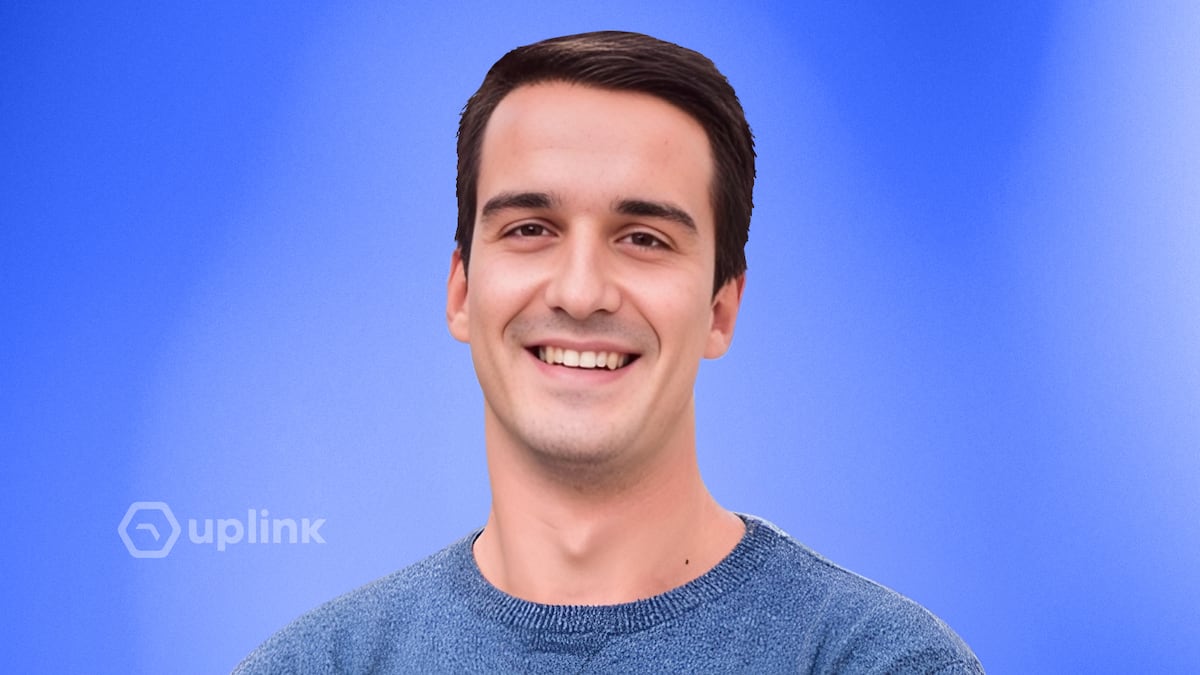Carlos Lei, CEO and co-founder of Uplink, a connectivity marketplace that uses decentralized physical infrastructure (DePIN) to let telecoms and enterprises offload traffic onto existing Wi-Fi and local networks.
We recently spoke with Carlos Lei about why the economics of connectivity no longer add up — and how Uplink proposes a decentralized fix.
Carlos Lei is the CEO and co-founder of Uplink, a DePIN company building a decentralized marketplace for connectivity. Their mission: to orchestrate the world’s fragmented Wi-Fi infrastructure, enabling telecommunications providers and enterprises to tap into a global network of routers for data offloading and private network deployment.
His journey began in 2015 at a university in Porto — “Mesh Valley,” as he calls it — after years developing advanced mesh protocols at Hype Labs. The turning point came when he realized the central challenge wasn’t linking devices to each other but getting the network itself online. That recognition pushed a shift from hardware to a software-first approach.
Below, Lei elaborates on Uplink’s strategic vision, the rationale behind migrating to Avalanche, and what lies on the horizon.
You’ve worked in connectivity since 2015, starting with Hype Labs. What was the original insight — and how did it lead to Uplink?
In 2014–2015 my co-founder and I met at the university in Porto. The city is dense with Wi-Fi and research labs, so we dove into mesh and built the best protocols we could. Then the reality set in: getting a single device online was hard, and enterprise rollouts still took years.
I remember looking at a streetlight in Lisbon running our mesh, linked across the block, yet the system wasn’t live. From my Airbnb on Wi-Fi, I stared at that pole and thought, “What if we could use this Wi-Fi to connect to it?”
The infrastructure existed; it was simply fragmented. That’s how we built Uplink, a marketplace connecting millions of routers for telecom use.
How much did those early economic lessons, particularly the unsustainability of building new infrastructure, drive you toward Web3 and the DePIN model?
100%. To keep up with 5G demands, telecom companies must invest billions in new cell towers, which simply doesn’t make economic sense. As we explored ways to automate payments and billing for shared networks, we started looking at Web3. DePIN is a perfect use case because it solves the chicken-and-egg problem of building supply by creating incentives from day one.
You’ve been recognized as a Forbes 30 Under 30. How have these milestones shaped your vision as a founder?
To be honest, while the recognition is impressive and meaningful, I don’t believe it has shaped me much as a founder. It feels good to see my team’s efforts being acknowledged, but these awards don’t determine your company’s success. Sometimes I think they can be a curse, as people may get caught up in the “circus” and lose focus on the real business. Ultimately, awards are meaningless if you don’t have a profitable, growing company that aims to lead the market.
What were the biggest technical challenges you faced in scaling this network, especially by focusing on software for existing hardware?
Our journey has been filled with technical obstacles. We had two choices. First: develop and sell our own hardware, which gives you control but means convincing millions of people to buy and deploy routers. For what we’re trying to achieve, that didn’t make sense. The second option: create software that works on all existing hardware. That’s extremely difficult. It took us over two years of development, failure, building partnerships, and learning — all while the technology kept evolving rapidly.
You chose to build on Avalanche. What was the rationale behind that decision?
We were initially chain-agnostic and just needed a tool. We looked at three things: transactions per second, community strength, and network uptime. We talked with a few chains, but we really connected with Avalanche’s DNA. They’re very business-focused and committed to the long term. I watched how they work with enterprises and their level of professionalism, and we wanted to be associated with that. The latest Avalanche upgrade also made it a clear choice for a company like ours.
Why is this new upgrade such a game-changer for Uplink?
The amazing thing is what they call the “cross-pollination of blockchains.” Instead of projects competing for resources, they can finally cooperate. In Web3, you have community partnerships, but on the technical side, it’s been the opposite; you’re competing for stakers. With this upgrade, our community and other projects’ communities can all work toward the same goals. Users staking on our network can also stake for others. It simplifies everything and creates a better dynamic between quality projects.
Many people might say, “I already have Wi-Fi.” What’s the real problem Uplink is solving, and why is it urgent?
If telecommunications doesn’t evolve, the connectivity you have today might be the best you’ll ever get. It’s no longer sustainable for telecom companies to keep spending billions on new cell towers, especially since they don’t provide good indoor coverage. The infrastructure already exists in current Wi-Fi routers. Our goal is to bring these routers into our network so telecom companies can do what’s called “network offloading.” This lets your phone automatically connect to a nearby router instead of a cell tower, without you noticing. You get faster speeds, it costs less for telecoms, and you get better service. We’re the marketplace that makes this happen.
How are enterprises using Uplink today?
We have several strong examples, plus more we can’t announce yet. We’ve connected an entire city where telecom companies are actively doing network offloading. In South America, a large enterprise has been using our network for two years — they’re saving significant money and getting much faster speeds than with their previous SIM cards. We’ve been very active with these enterprise clients while preparing to open this to the world.
How does your token model with ULX and network credits balance incentives?
It’s a simple burn-and-mint system. We have the ULX token, which is the main tradable asset, and the network credit, which has a fixed value. The primary purpose is for users to consume data. For example, if 100 GB costs $100 and $1 equals one network credit, the user must burn the ULX amount equivalent to 100 network credits. This lets ULX’s value fluctuate while keeping service prices stable for our business customers. ULX also rewards connectivity providers and community members who help map and verify the network.
What are the next big growth opportunities for Uplink? What should people expect?
The technology is mature, and we’re now focused on real revenue and growth. The next step is our TGE, which we expect early next year. That’s when the network goes fully live and open to the world. We’re at the point where we need to prove the tech can scale and generate sustainable revenue. Once we hit those milestones, we’ll open it to everyone.


